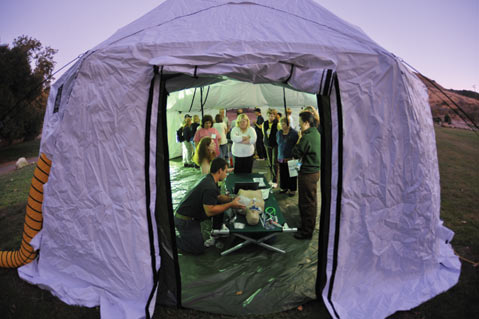Volunteer Corps Trained While Disaster Unfolded
Ready for Next Time

In an eerie twist of fate, a cadre of elite emergency medicine physicians and government officials arrived at El Capitan Ranch on Thursday evening just as the Tea Fire was revving up. They were here to train Santa Barbara County’s Medical Reserve Corps (MRC), the all-volunteer corps of citizens-including doctors, nurses, paramedics, veterinarians, communication specialists, and helicopter pilots-intended to bolster existing medical services overwhelmed in a major disaster.
Nancy Lapolla, director of the county’s Emergency Medical Services agency (EMS), said her entire five-person staff was there, listening to opening remarks by Direct Relief International’s director, Thomas Tighe, when phones started ringing. EMS decided to send two staff members to the Tea Fire’s Emergency Operations Center (EOC) for a 12-hour shift, replaced in the morning by a third. Lapolla said she was in constant communication with staff, law enforcement, and others, ensuring that vulnerable populations-especially people in skilled nursing, assisted living, and other types of facilities in the fire zone-were evacuated and that Cottage Hospital was not overwhelmed. EMS also was responsible for ensuring that an ambulance strike team was on site at Lower Manning Park command center. The agency quickly would have established a shelter for medically fragile residents, but that was not, in the end, necessary.
During the course of the next two days, Lapolla and EMS staff rotated shifts at the EOC while covering for each other at what she described as this “very important” training.
Santa Barbara’s two-year-old MRC has been a fledgling operation, at most, until now. The training weekend, called the Mark Stinson Austere Medicine Medical Reserve Corps Leaders Course, was a collaboration between Doctors Without Walls-Santa Barbara Street Medicine and EMS, and was funded almost entirely by a large grant from the Orfalea Foundation and another from the St. Francis Foundation. Of the 56 MRC members, 13 attended; many attendees who are not yet members, including Neighborhood Clinics’ medical director Neil Sullivan and several ER nurses, are expected to join.
“Usually, in a disaster, all the good-hearted people come out of the woodwork and say ‘I want to help,'” said EMS coordinator John Eaglesham. “Well, how do I know you are who you say you are?” Eaglesham, who has been in charge of developing the MRC here, hopes the corps will include people with a range of experience and backgrounds.
Simulated disasters whose victims required immediate care, far from hospital equipment, were featured on this weekend’s agenda. Phoenix-based anesthesiologist Kelly McQueen, an expert in surgery in humanitarian settings, was one of the instructors. “Six percent of disaster-related injuries require surgery,” she said. “I know how to set up a safe surgery setting.” Tareg Bey, from the University of California at Irvine, instructed how to respond to chemical and radio-nuclear incidents. Another VIP with a hyperactive beeper was Jeffrey Rubin, director of Disaster Medicine for California’s Emergency Medical Services Authority, who was overseeing medical services in four separate fire zones but still maintained a presence at the El Capitan training. Rubin said there are 40 MRCs in the state, but the Santa Barbara training was groundbreaking. Santa Barbara’s MRC is unique in its high degree of physician involvement, Rubin added, and cooperation between the not-for-profit and government sectors.
The MRC was born in the weeks following 9/11, when President George W. Bush founded the Citizen Corps, a network of citizen volunteer groups ready to deploy in emergencies. It is coordinated through the Surgeon General’s office, though scant funding is provided.
Mimi Doohan, a key weekend organizer, hopes the MRC training will continue year ’round as members help with Doctors Without Walls’ other programs, like its street rounds and upcoming women’s clinic for the homeless.
When the non-simulated disaster broke out Thursday, Doohan wondered if the training should continue. “But then [I thought], this is our part. This is what we can do now. Not everybody can be on the front lines.”



